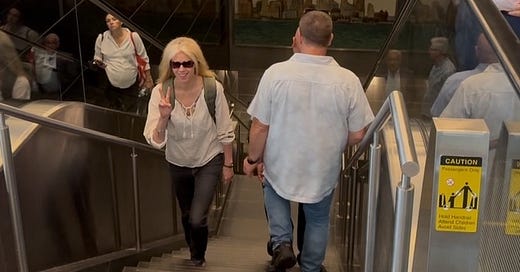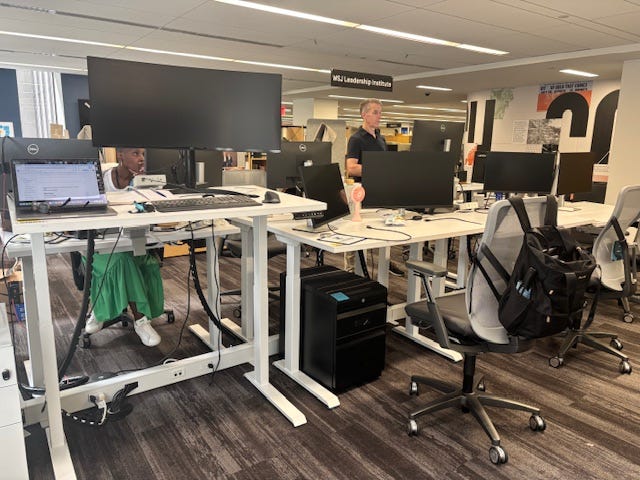Why are we so scared of this 4-letter word?
A debate over my book cover and 'hard' led to this list of five doable discomforts — all of which have a return on investment.
Warmup
“I think you should consider switching them.”
The deadline already had passed to approve a new cover for the paperback version of my book, Not Too Late. The publisher’s patience was waning.
And now my spouse, the person whose opinion I trust most in the world, wanted me to flip the quotes of praise on the front and back covers.
On the back:
“This story of personal transformation is thrilling.” — Gretchen Rubin, #1 New York Times bestselling author of The Happiness Project.
On the front:
“Not Too Late will inspire you to make big positive changes—to do hard things you didn’t think you could.” — Michael Easter, bestselling author of The Comfort Crisis.
Both gracious endorsements. There was no bad choice. Still, I knew where we were headed even before I asked.
Why?
“I just think people are scared of the word ‘hard.’ And if that’s the first thing they see on the cover, they might not read it.”
Post
I opted to procrastinate an hour longer and take the dog for a walk.
This had/has been the dilemma since my book first published a year ago: How to reach the widest audience possible without betraying the truth of its message.
Which was that the gateway to a life better than any I’d imagined possible had come not through a series of hacks, but through years of hard work mastering something new.
My “something” happened to be a sport, one called obstacle course racing, which I’d taken up in middle age. But I knew people who’d achieved similar transformation by learning a new language, volunteering as a firefighter, taking acting lessons, starting their own business.
No quick fixes. No 7-minute promises of good health or happiness. Just digging in. Again, and again.
For me, a once scrawny kid last-picked for sports teams who’d morphed into an unathletic adult glued to her screens, doing that digging by pursuing competitive athletics in my late 40s ultimately upended what I believed was capable of doing.
As my mind and body changed, I began talking to experts about the science, tools and tactics that fuel positive pivots in behavior.
Eventually, their advice and my story turned into my book Not Too Late and this newsletter.
The science of ‘hard things’ — and why we shouldn’t shy from them
Now, back to the book’s cover.
Climbing through the rocky Hudson Highlands hills, my 20-lb Cavapoo happily launched himself up boulders and over falling trees like a dog twice his size.
Watching him, I chewed things over while listening to a recent podcast with Michael Easter — author of that “hard” quote and someone I’ve come to think of fondly as my wiser (younger!) philosophical brother who was early to the game on the power of doing hard things.
As fate would have it, he’d recently spoken with neuroscientist Andrew Huberman about this very topic.
Their conversation runs about 3 hours. Among other things, these three things really rang true to me:
Even though the comforts of modern life are many, life feels hard for many us. So the key is leaning into discomforts that can actually make other discomforts fade away.
Any dopamine reward that is not preceded by substantial effort can potentially destroy us in the form of addiction — think social media, alcohol use, eating sugary foods.
As we spend our dopamine reserves, at each point it’s worth asking: Are we actually investing them in something where there will be a real return on investment (ROI) in terms of future health, happiness, financial security, etc.?
Michael and Andrew also talked about ways to ease into hardship. Which got me to thinking …
5 doable discomforts
Early on, one of my book publicists encouraged me to make things sound easier for people. Particularly when I was talking about the book on TV.
“Speak in soundbites. Tell the person sitting on their couch in Ohio how they can do what you did in three steps.”
Initially, I was flummoxed (and probably more annoyed than I should have been).
How to distill into three steps what had been eight years of waking before dawn to train even when a full inbox of work emails awaited, leaving my warm bed to run in the sleet and rain, reordering many of my priorities, battling anxiety after a difficult medical diagnosis to return to the gym, putting myself repeatedly in situations with much younger people where I looked foolish, drinking less alcohol, upending my eating habits, showing up at the starting line of races always feeling like an imposter …?
That was thousands of daily steps. And each of them mattered.
Yet, over time, I’ve come to believe she was right fundamentally. And that making harder choices that lead to better outcomes actually doesn’t have to be that hard.
Here, five examples most people can try that come with a real return on investment:
No chair at work. I don’t have one. We have standing desks at The Wall Street Journal and on my first day, I politely asked facilities to remove my chair. The truth was, as a knowledge worker in the office, I spend a lot of hours in meetings where I must sit. So, when I’m back at my own desk, I don’t even want the option. Sometimes it sucks, like during lunch. ROI: I reduce my deletrious sitting-and-screens time each day.
Take the stairs. Whenever I get off the train at Grand Central after a 90-min commute, there’s a choice of two massive escalators — or one long staircase. The overwhelming majority of commuters jump on the escalators. I don’t, even if I’ve run earlier that morning and my legs hurt. ROI: It’s harder, but healthier and also, less crowded! For a masterclass on why we should take the stairs, see Michael’s 2% manifesto. (Hint: that’s the percentage of people who choose stairs over an escalator.)
Sit in a public place without scrolling on the phone. This is more painful than I’d like to admit. Every moment of potential boredom is super easy to fill with an Instagram or email check, Wordle, a news headline click. Plus, when I’m not looking at my phone, I often end up watching other people — who then look up from their phones and no doubt wonder, “Why is that weird woman staring at me?” ROI: Good ideas often come in these moments of self-induced boredom. Now I carry a small notebook with me everywhere I go to write them down.
No TV or music in the background. In the past, I performed all my house chores with background noise as a distraction. Now I sometimes fold laundry in silence. Do the dishes without TV. (The only exception: when the New York Mets play.) ROI: Silence may have health benefits such as lowering cortisol or blood pressure.
Walk, hike or run without a plan or map. Recently, I kept going on a trail at the spot where I normally turn around. I had no idea where it led. I had no water, no food and after 90 minutes was pretty sure I was lost high up on the mountain. Bears are not uncommon where I live. Still, it was mossy and beautiful with spectacular views. My brain worked overtime figuring out how I’d eventually get back down. Then, I ran into some hikers who knew the way out. We struck up a conversation and one invited me to dinner. ROI: Cognitive stimulation, a new favorite running path, and free meal.
My desk on the left (no chair!)
Cooldown
What I can say now, is that small hard choices like these are what helped me to complete a single obstacle course race. And then one more. And then another.
This weekend, I’ll run my 54th race in Utah. That tally includes three world championships and last year, I ranked number one in my age group in the U.S. National Series for Spartan Race — something once unimaginable to me and most people who know me.
It all began with one single hard choice nine years ago: To believe I wasn’t fully-baked as a human being and could break my cycle of sameness.
When I got back to the house after the walk, neither of us spoke about the paperback cover. We both knew what my decision would be — 20 years together will do that. I finally fired off an email to my publisher with the final tweaks to my cover.
Here’s a sneak peak. It publishes in September.
Thanks for reading. As always, find something you love. Dig in. Stick with it when things get hard.
Wendy







Great suggestions on five doable discomforts. It's truly a muscle that starts with the boring basics and builds from there!
Love the cover !!!
By the way / any chance you are doing the citizens bank spartan in September.
My son and I will be there.
STAY ON OFFENSE 💪.